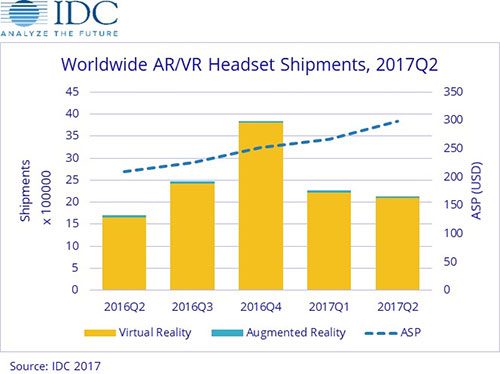The market for augmented reality (AR) and virtual reality (VR) headsets keeps expanding.
In the second quarter (Q2) of 2017, vendors shipped 2.1 million AR and VR headsets, a 25.5 percent year-over-year increase, said IDC in its latest report on the market. Shipments slipped a bit compared to the first quarter, when units shipped totaled 2.3 million, noticed the research firm.
Challenges abound, including consumers to buy into the burgeoning ecosystem, and not just monetarily.

“The VR market is still very young and consumers seem to be taking a cautious approach,” said IDC senior research analyst Jitesh Ubrani. “With plenty of headset options already in the market and even more coming soon, hardware isn’t the issue. The bigger challenge is the slow growth in content that appeals to a mass audience, combined with the confusion associated with a lack of cross-platform support.”
Although the blended experiences provided by AR systems show promise, for now the market belongs to VR. AR headsets overlay computer imagery over a user’s physical surroundings while VR headsets generally deposit users into virtual worlds and environments.
The vast majority of headsets shipped last quarter were of the VR variety (98 percent). Tethered VR headsets, the type that requires a physical connection to a PC or other computing device, increased their market share to 43 percent in Q2 from 34 percent in Q1. IDC credits the jump to price reductions affecting the Oculus Rift from Facebook and Sony’s success in getting more PlayStation fans to spring for its VR headset.
AR may be a tiny blip on the market’s radar, but that may soon change as tech giants set their sights on the technology.
“Now that Apple and Google are both focused on helping developers create AR experiences on their platforms—through ARKit for iOS and ARCore for Android—we can expect to see a flood of new AR apps appearing on smartphones later this year and into next,” said IDC vice president Tom Mainelli. “These developments should eventually lead to consumer-centric AR glasses, but that won’t happen in meaningful volume, at affordable price points, for some time.”
Samsung led the market in Q2, with shipments of 568,000 VR headsets and a 26.7 percent slice of the pie. Its success is somewhat owed to the practice of bundling Gear VR headsets with the popular Galaxy S8 and S8+.
Second-place Sony shipped 519,400 units and claimed 24.4 percent of the market. Facebook came in third, with shipments of 246,900 Oculus Rift headsets. TCL and HTC rounded out the top five.
Pedro Hernandez is a contributing editor at Datamation. Follow him on Twitter @ecoINSITE.
Huawei’s AI Update: Things Are Moving Faster Than We Think
FEATURE | By Rob Enderle,
December 04, 2020
Keeping Machine Learning Algorithms Honest in the ‘Ethics-First’ Era
ARTIFICIAL INTELLIGENCE | By Guest Author,
November 18, 2020
Key Trends in Chatbots and RPA
FEATURE | By Guest Author,
November 10, 2020
FEATURE | By Samuel Greengard,
November 05, 2020
ARTIFICIAL INTELLIGENCE | By Guest Author,
November 02, 2020
How Intel’s Work With Autonomous Cars Could Redefine General Purpose AI
ARTIFICIAL INTELLIGENCE | By Rob Enderle,
October 29, 2020
Dell Technologies World: Weaving Together Human And Machine Interaction For AI And Robotics
ARTIFICIAL INTELLIGENCE | By Rob Enderle,
October 23, 2020
The Super Moderator, or How IBM Project Debater Could Save Social Media
FEATURE | By Rob Enderle,
October 16, 2020
FEATURE | By Cynthia Harvey,
October 07, 2020
ARTIFICIAL INTELLIGENCE | By Guest Author,
October 05, 2020
CIOs Discuss the Promise of AI and Data Science
FEATURE | By Guest Author,
September 25, 2020
Microsoft Is Building An AI Product That Could Predict The Future
FEATURE | By Rob Enderle,
September 25, 2020
Top 10 Machine Learning Companies 2020
FEATURE | By Cynthia Harvey,
September 22, 2020
NVIDIA and ARM: Massively Changing The AI Landscape
ARTIFICIAL INTELLIGENCE | By Rob Enderle,
September 18, 2020
Continuous Intelligence: Expert Discussion [Video and Podcast]
ARTIFICIAL INTELLIGENCE | By James Maguire,
September 14, 2020
Artificial Intelligence: Governance and Ethics [Video]
ARTIFICIAL INTELLIGENCE | By James Maguire,
September 13, 2020
IBM Watson At The US Open: Showcasing The Power Of A Mature Enterprise-Class AI
FEATURE | By Rob Enderle,
September 11, 2020
Artificial Intelligence: Perception vs. Reality
FEATURE | By James Maguire,
September 09, 2020
Anticipating The Coming Wave Of AI Enhanced PCs
FEATURE | By Rob Enderle,
September 05, 2020
The Critical Nature Of IBM’s NLP (Natural Language Processing) Effort
ARTIFICIAL INTELLIGENCE | By Rob Enderle,
August 14, 2020

Datamation is the leading industry resource for B2B data professionals and technology buyers. Datamation's focus is on providing insight into the latest trends and innovation in AI, data security, big data, and more, along with in-depth product recommendations and comparisons. More than 1.7M users gain insight and guidance from Datamation every year.
Advertise with TechnologyAdvice on Datamation and our other data and technology-focused platforms.
Advertise with Us
Property of TechnologyAdvice.
© 2025 TechnologyAdvice. All Rights Reserved
Advertiser Disclosure: Some of the products that appear on this
site are from companies from which TechnologyAdvice receives
compensation. This compensation may impact how and where products
appear on this site including, for example, the order in which
they appear. TechnologyAdvice does not include all companies
or all types of products available in the marketplace.